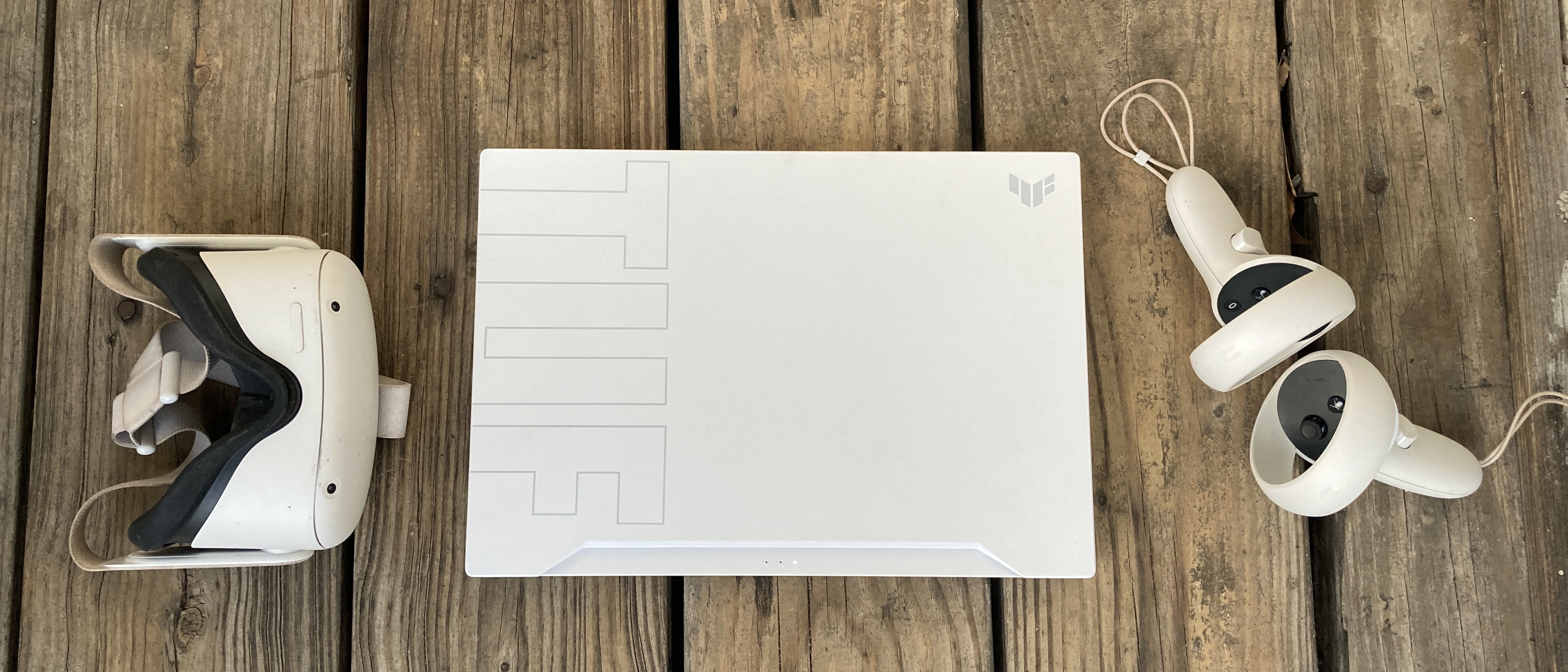Laptop Mag Verdict
The Asus TUF Dash F15 has a striking, frosty-white chassis that stays relatively cool under pressure, but its absent webcam and dim display are a bummer
Pros
- +
Striking, all-white design
- +
Competition-beating battery life
- +
Military-tested chassis
- +
Remains relatively cool while gaming
Cons
- -
No webcam
- -
Quiet speakers
- -
Dim display
Why you can trust Laptop Mag
Price: $1,449
CPU: Intel Core i7-11375H processor
GPU: Nvidia GeForce RTX 3070
RAM: 16GB
Storage: 1TB SSD
Display: 15.6-inch, 240Hz
Battery: 6:53 (non-gaming)
Size: 14.2 x 10 x 0.8 inches
Weight: 4.4 pounds
The Asus TUF Dash F15, packed with an Nvidia GeForce RTX 3070 GPU, elicited a surprised gasp out of me when I pulled it out of the box. In a sea of black-and-gray laptops, the TUF Dash F15 ivory chassis stands out of the crowd; it’s reminiscent of a Stormtrooper’s frosty-white armor. It also has a sturdy, military-tested chassis that can handle drops, humidity, extreme conditions, and more.
The TUF Dash F15 remained relatively cool throughout my gaming sessions although the fans aren’t the quietest. It also outlasted other Nvidia 30-series laptops on our battery life test, offering close to a 7-hour runtime (which isn’t half bad for a gaming laptop). Some downsides of the TUF Dash F15, however, are the absent webcam, its dim display and quiet speakers.
Still, if a frosty-coated laptop with a sturdy, cool chassis and decent frame rates is your jam, the TUF Dash F15 is a great choice.
Asus TUF Dash F15 pricing and configurations
The Asus TUF Dash F15 starts at $1,099 and comes with an Intel Core i7-i7-11370H processor with 16GB of RAM, a 512GB SSD, an Nvidia GeForce RTX 3060 GPU, and a 15.6-inch, 1080p, 144Hz refresh-rate display.
My $1,449 review unit sports the same CPU and RAM, but features 1TB of SSD storage and an Nvidia GeForce RTX 3070 GPU. The 15.6-inch, 1080p display offers a 240Hz refresh rate.
There are two color variants you can choose from: Moonlight White and Eclipse Gray.
Asus TUF Dash F15 design
I said, “Wow!” when I pulled the Asus TUF Dash F15 out of the box. The futuristic, all-white gaming rig looks like it was carved out of a Stormtrooper’s armor. The word “TUF” is emblazoned across the left side of the lid, from the top bezel to the hinge. On the top-right is a small, gray TUF logo.
Sign up to receive The Snapshot, a free special dispatch from Laptop Mag, in your inbox.

The chassis has a plastic-like feel, but don’t let it fool you — this Asus gaming rig has a sturdy build that matches its name. The TUF Dash F15 is as tough as nails, meeting MIL-STD-810H durability standards. This means the TUF Dash F15 can sustain drops, vibration, humidity and extreme temperatures. Whether you’re accident-prone or plan to use the TUF Dash F15 in harsh conditions, this gaming rig can handle it all.
Open the lid and you’ll find the 15.6-inch, 1080p display surrounded by thin bezels, save for the large chin that sports a subtle, futuristic Asus logo. The deck is a stunner with an island-style keyboard and a backlight that Asus calls “Bolt Blue,” but in my opinion, it has more of a mint-green hue. The letters and symbols, superimposed on white keys, are illuminated with this mint-green light. The W, A, S, D keys look gorgeously different with black lettering and lit-up, mint-green keys.
Under the spacebar, you’ll find a medium-sized, all-white touchpad. There is a subtle mint-green line in the middle to help users better differentiate between left-and-right clicks. On the underside of the laptop are several vents and four rubber feet to give the TUF Dash F15 better ventilation during taxing gaming sessions.
At 4.4 pounds and 14.2 x 10 x 0.8 inches, the Asus TUF Dash F15 is within the same weight class and thickness as its fellow Nvidia 30-series competitors: the Gigabyte Aero 15 (At 4.4 pounds and 14 x 9.8 x 0.8) and the Alienware m15 R4 (5 pounds, 14.2 x 11 x 0.7~0.8 inches).
Asus TUF Dash F15 ports
The Asus TUF Dash F15 has a decent selection of ports.
On the left side, you'll find an RJ45 Ethernet port, an HDMI 2.0 input, a USB 3.2 Gen 1 Type-A port, a Thunderbolt 4 port and a headset jack. On the right side, there are two more USB 3.2 Gen 1 Type-A ports.
Asus TUF Dash F15 display
The Asus TUF Dash F15 sports a 15.6-inch, 1080p display with a 240Hz refresh rate and a 3ms response time. The panel supports adaptive sync, which eliminates visual tearing and offers a fluid gaming experience.

In Hitman 3, Agent 47 walks through the gritty, shabby streets of Berlin, and the TUF Dash F15’s display captures snapshots of the city’s beauty, including the incredible murals that enliven the bleak, dismal buildings. One strange-looking mural features a skeleton wearing a crown and plastic-shutter glasses. The TUF Dash F15’s display gave me a crisp and clear perspective of the odd mural, capturing all the striking elements of the massive artwork, but the colors could be richer and more vivid.
I also watched The Boogie trailer and feasted my eyes on a brickface building in Chinatown with yellow storefront signs, a bright-red neon sign that says “Fortune Teller,” and a colorful array of flyers on a door. I was impressed by the subtle wrinkles and pockmarks I could spot on Taylor Takahashi’s face. However, the blue dye at the ends of Taylour Paige’s faux locs could be more striking.
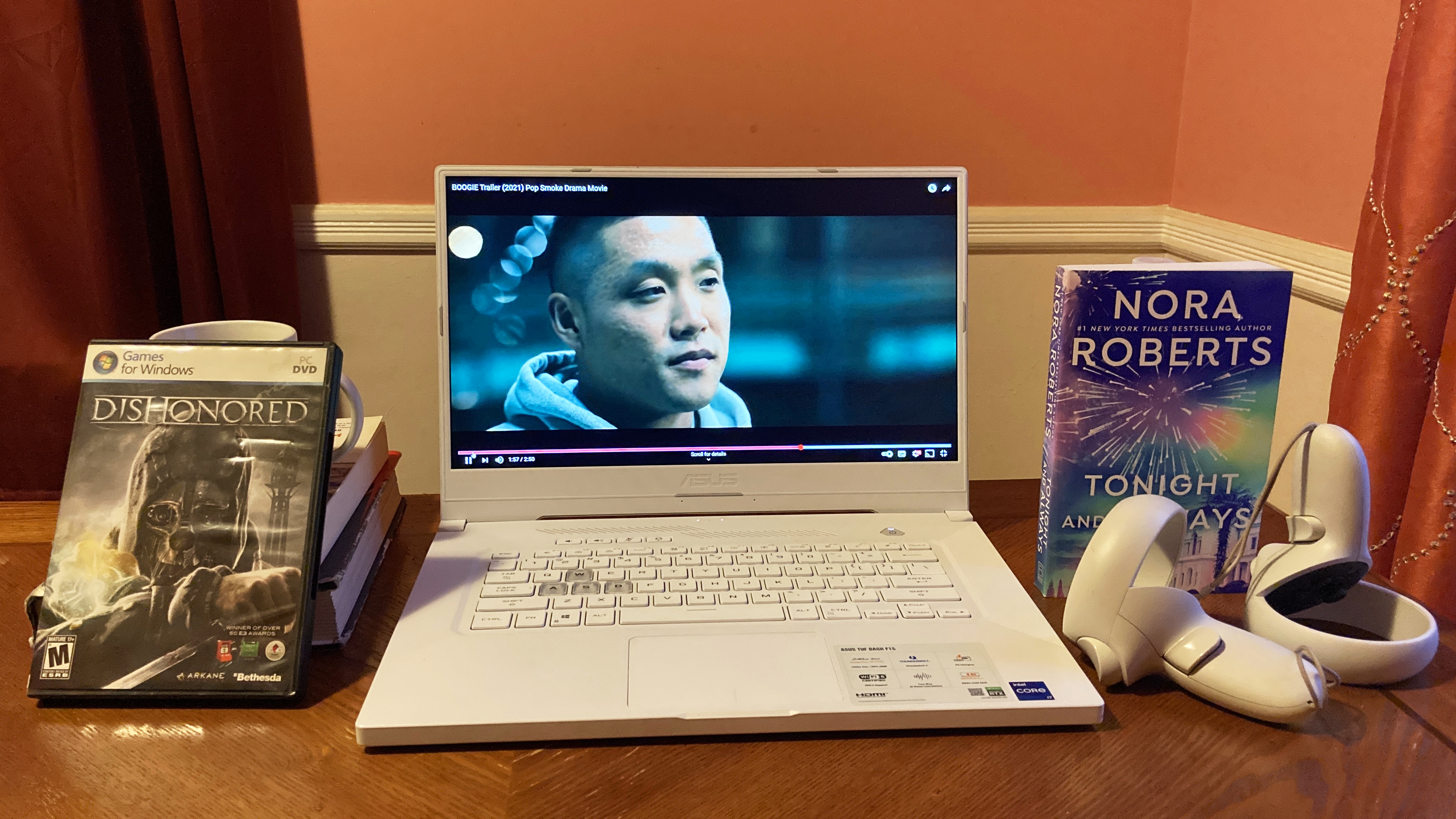
According to our colorimeter, the TUF Dash F15’s display covers 78% of the DCI-P3 color gamut, which is a larger spectrum than the average mainstream laptop (69%). The TUF Dash F15 couldn’t compete with the Aero 15 nor the m15 R4, which covers 85% and 150% of the DCI-P3 color gamut. Considering the fact that the Aero 15 and the m15 R4 have 4K panels, I won’t ding the TUF Dash F15 for its 78% coverage (which is actually above average). As mentioned, I enjoyed gaming and streaming videos on the display.
The TUF Dash F15’s display is pretty dim, only offering 265 nits of brightness. This is dimmer than the average mainstream gaming laptop (281 nits). The Aero 15 and the m15 R4 are brighter, reaching 393 nits and 362 nits, respectively.
The TUF Dash F15’s 0.23 Delta-E color-accuracy score beats the category average, which is 0.28 (The closer to zero, the better). It crushes the m15 R4’s 0.32 score, but matches with the Aero 15 (0.23).
Asus TUF Dash F15 audio
The TUF Dash F15 sports dual, bottom-firing speakers tuned by DTS X Ultra.
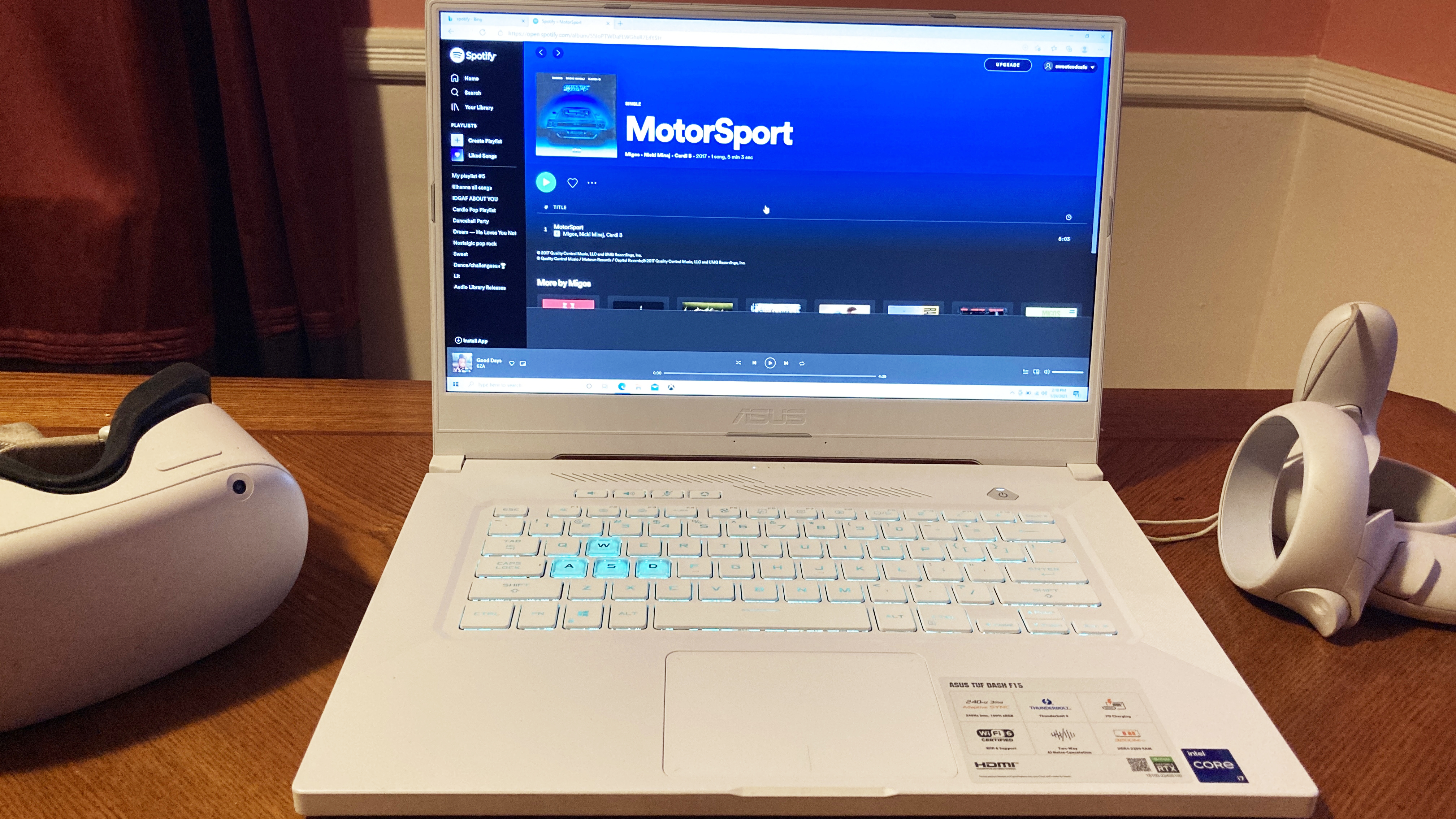
I listened to “Good Days” by SZA, and while the R&B singer’s voice sounded smooth and honey-like, the sound was a little too quiet — even at max volume. The TUF Dash F15’s speakers couldn’t fill my large-sized testing room. You can tune the speakers with the DTS X app, which offers seven profiles: Automatic, Music, Voice, Movies, Strategy, RPG and Shooter. Automatic optimizes the audio depending on content type; it sounded much better than all the other profiles, offering full, well-balanced sound.
For gaming, I preferred the Shooter profile as it made NPC conversations sound clearer and sharper. In Hitman 3, as Agent 47 crept through the streets of a gritty town in China, I heard two characters discussing their suspicions about the strange goings-on of a nearby restaurant. Thanks to the useful intel, I knew immediately where I needed to start my mission: a noodle eatery. However, as mentioned, the speakers sounded a little too quiet, especially when the cooling fans kicked in.
Asus TUF Dash F15 keyboard and touchpad
The Asus TUF Dash F15’s island-style keyboard with Chiclet-style keys is enjoyable to type on. It’s visually stimulating with a striking, mint-green backlight, and it provides tactile satisfaction with its bouncy, clicky keys that have a travel distance of 1.7mm.
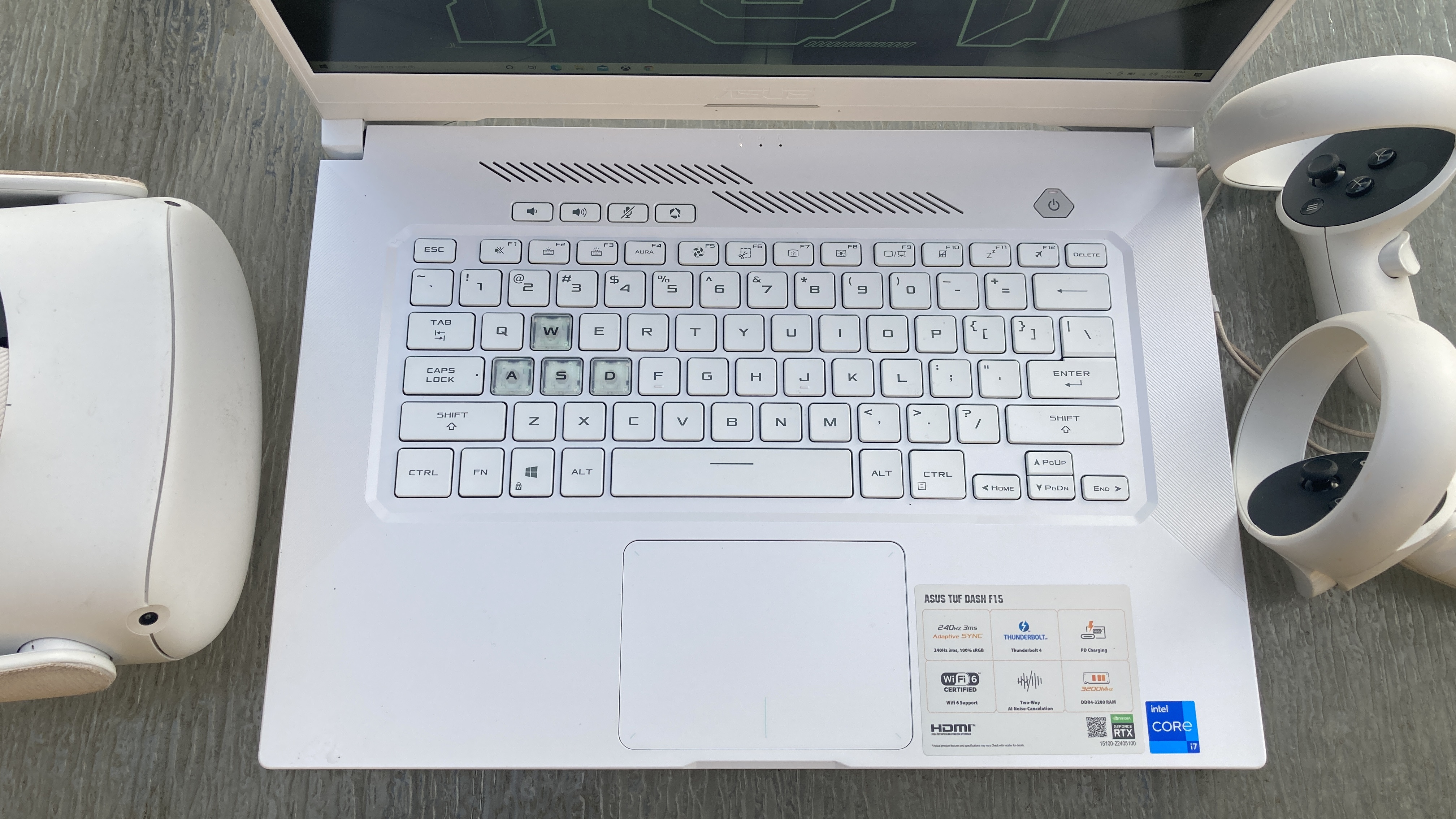
On the 10fastfingers.com test, I reached 87 words per minute with 99%, which matches my typical typing rate.
Above the function keys, you’ll discover four isolated hot keys for easy access to volume, mute and the Armoury Crate app, which gives you details on the CPU, GPU and RAM. The W, A, S, and D keys are the most conspicuous on the keyboard as they are the only ones totally illuminated with mint-green backlighting.
The 4.1 x 2.9-inch Windows Precision touchpad has a grippy feel that I love; it’s not too slippery and not too resistant. It’s just right; I had no issues executing pinch-to-zoom, two-finger scrolling, and three-finger taps as I browsed the internet.
Nvidia’s 30-series era begins
The Asus TUF Dash F15 is the second Nvidia 30-series laptop I’ve had the privilege of reviewing and I couldn’t wait to test how well it could handle my favorite triple-A games. This particular model sports an Nvidia GeForce RTX 3070 GPU, which is based on Nvidia’s second-gen Ampere architecture; this is the chip maker's first 8nm chip. Nvidia has somehow found a way to squeeze in more transistors into its next-gen chipset, which means more power in a tiny package.
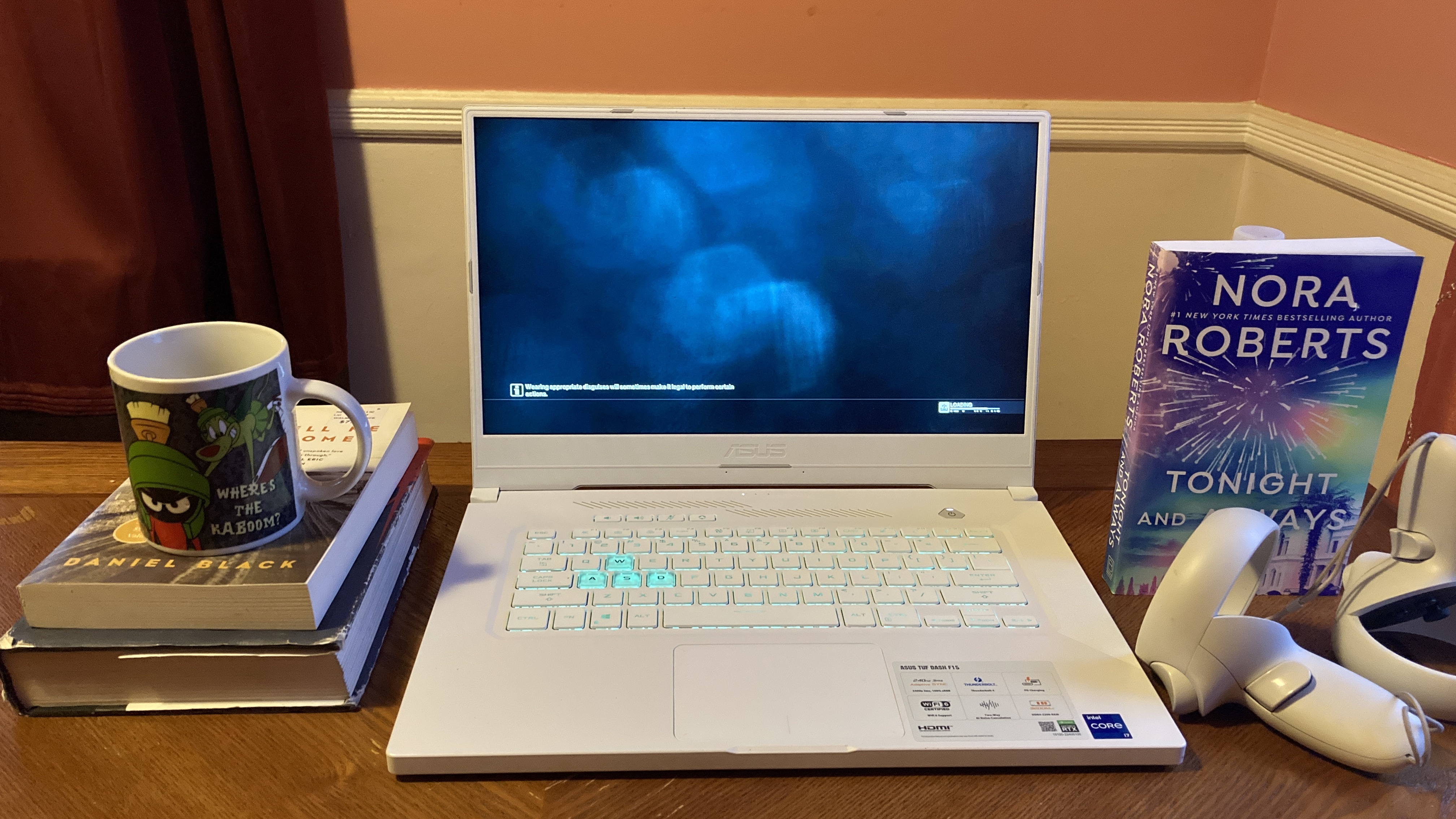
The new 30-series GPU launches a new era of real-time ray tracing, artificial intelligence (AI) and programmable shading. The Ampere chips offer a powerful holy trinity of processors: the Shader, second-gen RT Cores and the third-gen Tensor Core. The Shader manages 3D shading (it elevates your graphics with better lighting, darkness and color levels). RT Cores are responsible for ray-tracing tech. The Tensor core handles AI computing.
Thanks to the third-gen Max-Q design, the new 30-series laptops will benefit from the chips’ Whisper Mode 2.0 and Dynamic Boost 2.0. WhiserMode helps your device run quieter so that your laptop doesn’t sound like a jet engine ready to take off into the sky. Dynamic Boost 2.0 uses AI to deliver power to the CPU, GPU and VRAM for a dramatic boost in performance. DLSS (Deep Learning Super Sampling) is another 30-series treat you’ll appreciate. It is a revolutionary AI feature that boosts frame rates without compromising image quality nor exceeding the thermal limits of the gaming rig.
Nvidia’s Optimus technology, a feature that toggles between discrete and integrated graphics to reduce power consumption, has also received an upgrade. With Optimus, your laptop will offer longer battery runtimes (compared to non-Optimus devices). Optimus determines which GPU is best depending on your current workload. For example, with casual video streaming, your integrated GPU will kick in. If you’re gaming or diving into photo-editing work, Optimus will switch on the discrete GPU. The new Advanced Optimus tech utilizes a hardware switch that manages which GPU is connected to the panel for the most optimal performance.
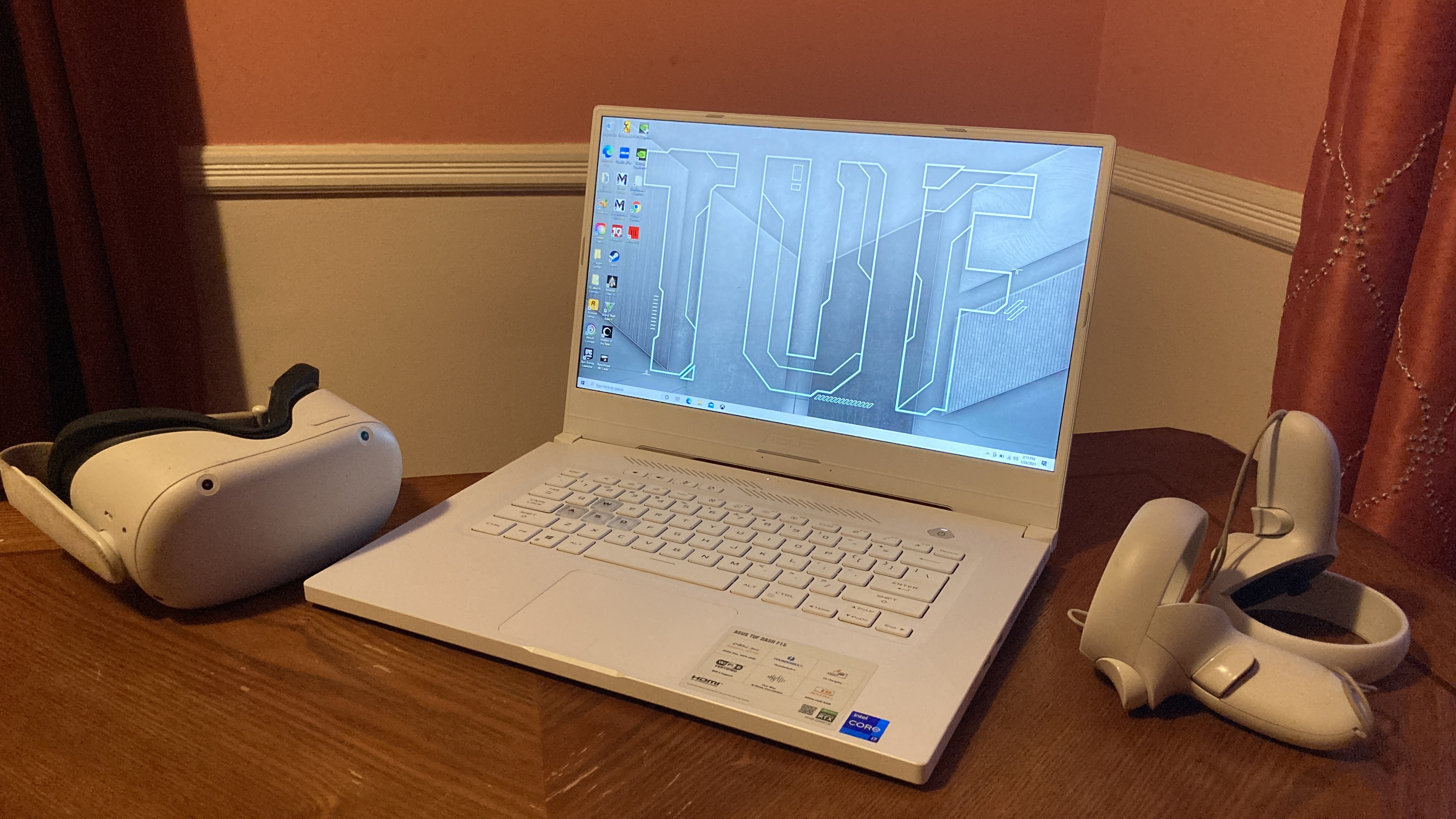
Thanks to Advanced Optimus, 1440p displays can deliver 240Hz refresh rates and 4K screens and crank out 120Hz refresh rates. The new Optimus technology is more compatible with Nvidia’s G-Sync technology than previous iterations. G-Sync, by the way, aligns the panel’s refresh rate with the GPU for smoother gameplay. Speaking of G-Sync, Reflex is another advantageous Nvidia 30-series tech that helps to reduce latency.
Last but not least, if you have an interest in streaming on Twitch or other platforms, you’ll love Broadcast. It’s an AI-powered functionality that reduces ambient noise, offers automatic framing during webcam usage, and provides cool virtual background effects.
Asus TUF Dash F15 gaming, graphics and VR
The TUF Dash F15 is packed with the new 30-series chipset: the Nvidia GeForce RTX 3070 GPU with 8GB of VRAM. We compared the TUF Dash 15 with the Aero 15 and the m15 R4; both rivals are equipped with the same GPU.
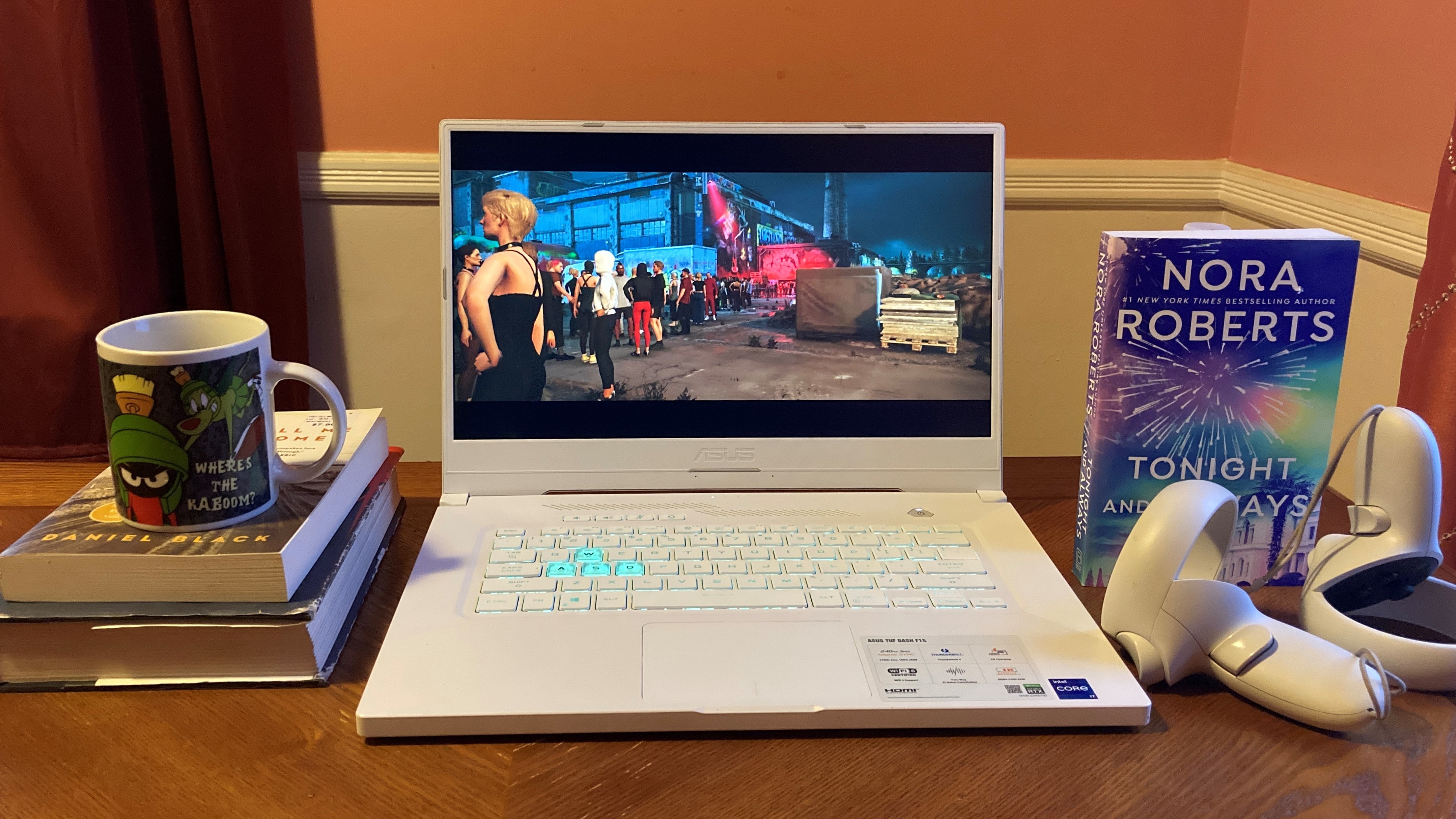
When the TUF Dash F15 ran Assassin’s Creed Odyssey (1080p, Very High), it delivered 51 frames per second, which surpassed the average mainstream gaming laptop (48 fps). The TUF Dash F15 got crushed by the Aero 15’s 65 fps and the m15 R4’s 67 fps.
The Asus rig also ran Assassin’s Creed Valhalla (1080p, Very High), a title optimized for Nvidia’s 30-series graphics. The TUF Dash F15 notched 55 fps; again, it got its butt kicked by the Aero 15 (62 fps) and the m15 R4 (70 fps).
On the Grand Theft Auto V benchmark (1080p, Very High), the TUF Dash 15 hit 84 fps, sailing past the average mainstream gaming laptop (69 fps). The Aero 15 and the m15 R4 whizzed past the TUF Dash F15 with frame rates of 96 fps and 108 fps, respectively.
During the Shadow of the Tomb Raider test (1080p, Very High), the TUF Dash F15 served up 69 fps, which crushed the average mainstream gaming laptop (56 fps). Again, the TUF Dash F15 couldn’t outperform the Aero 15 (76 fps) and the m15 R4 (77 fps).
Running the Far Cry: New Dawn benchmark (1080p, Ultra), the TUF Dash F15 offered 79 fps, which outpaced the category average by four frames (74 fps). However, the Asus couldn’t beat the Aero 15 (97 fps) and the m15 R4 (91 fps).
Finally, we ran the Red Dead Redemption 2 benchmark; the TUF Dash F15 reached 52 fps, which crushed the average mainstream gaming laptop (45 fps), The Asus gaming rig almost caught up to the Aero 15 (58 fps), but not quite. The m15 R4, of course, slew the competition with a rate of 69 fps.
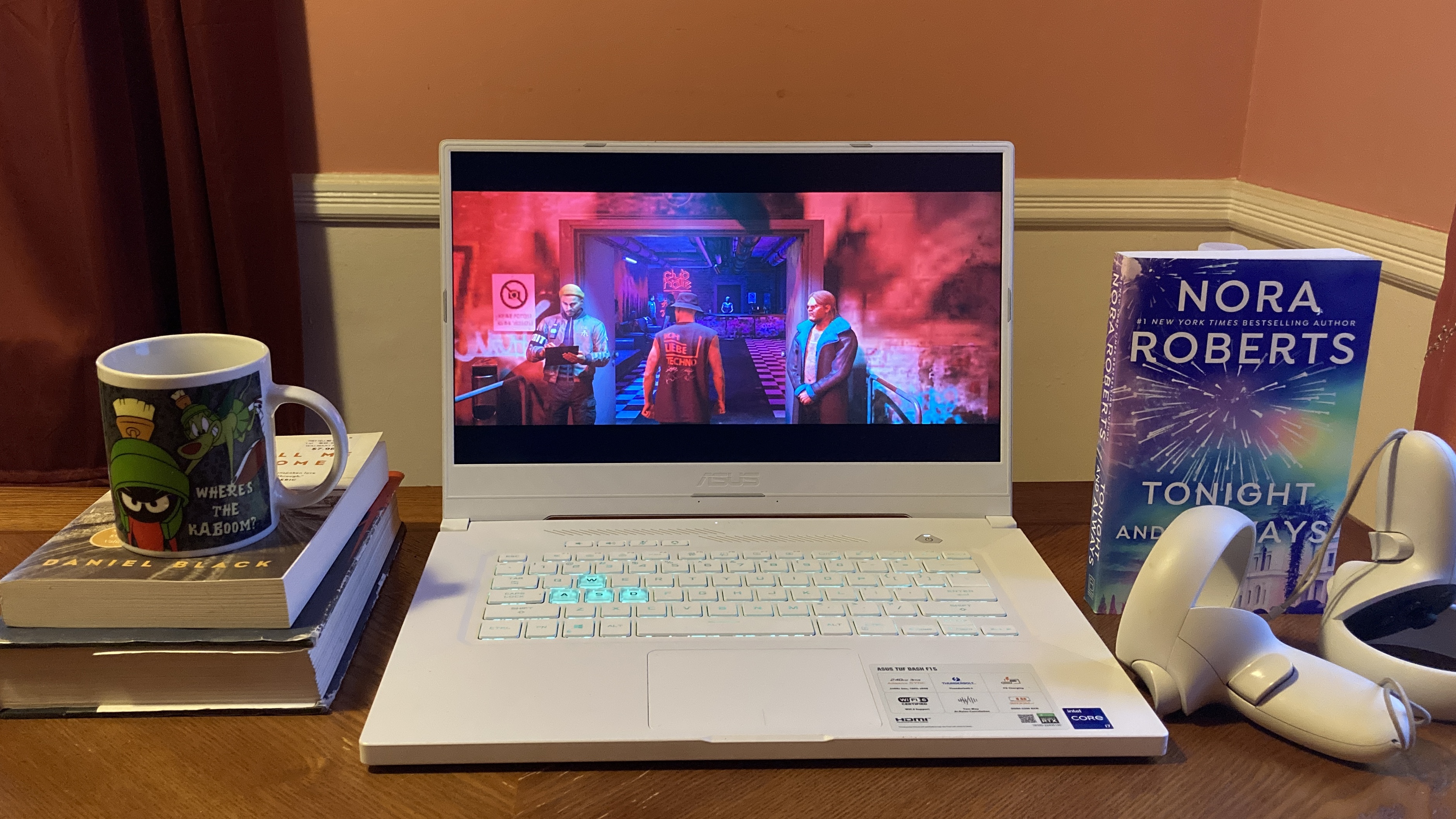
To test the TUF Dash F15’s virtual reality power, we ran VRMark Blue, the most taxing VR benchmark. It obtained a score of 2,378, which outperformed the average mainstream gaming laptop by a landslide (1,875). Once again, the Aero 15 and the m15 R4 crushed the poor Asus laptop with scores of 2,726 and 3,111, respectively.
Although all three laptops have the same GPUs, we theorize that the TUF Dash F15 likely couldn’t keep up with its Nvidia 30-series competitors due to CPU differences. The TUF Dash F15 has a 3.3-GHz Intel Core i7-11375H CPU, which has 4 cores and 8 threads while the Aero 15 and the m15 R4 sport 2.2-GHz Intel Core i7-10870H CPUs with 8 cores and 16 threads. Still, it’s important to note that the TUF Dash F15’s outperformed the average mainstream laptop on every gaming benchmark.
Asus TUF Dash F15 performance
As mentioned, the TUF Dash 15 is powered by an 11th Gen Intel Core i7-11375H CPU, 16GB of RAM and a 1TB SSD. The Asus gaming rig easily juggled 40 Google Chrome tabs (four were playing 1080p YouTube videos simultaneously) like a talented circus clown. I didn’t experience any slowdowns or lag.
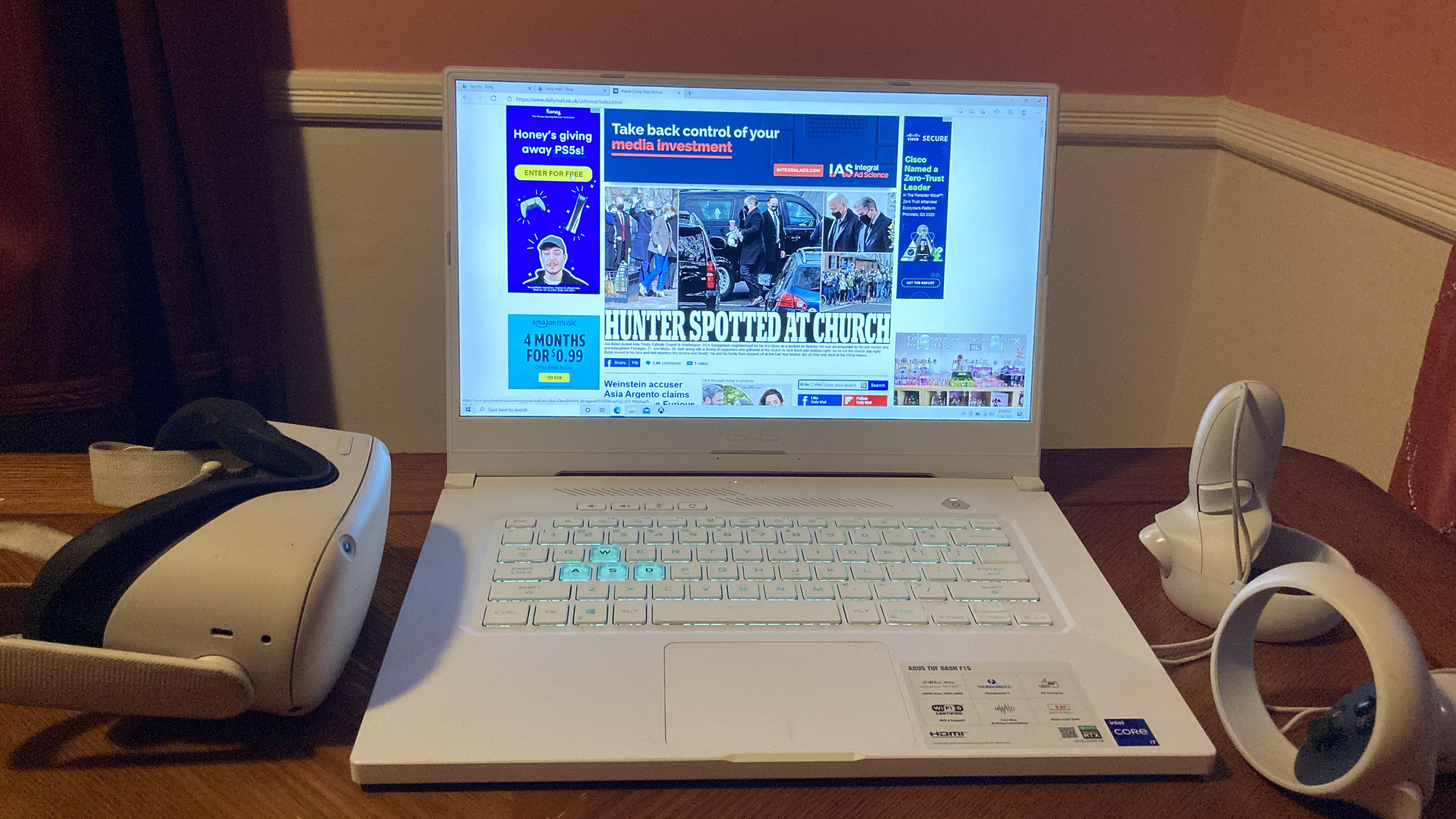
Unfortunately, on the Geekbench 5.0 overall performance test, the TUF Dash 15 couldn’t outperform the average mainstream laptop (5,785) with a measly score of 5,173. The Aero 15 and m15 R4 smoked the Asus gaming rig with scores of 7,968 and 7,642, respectively.
On the Handbrake test, the TUF Dash 15 transcoded a 4K video to 1080p in 10 minutes and 40 seconds, which is longer than the average mainstream gaming laptop (8:41), the Aero 15 (8:10) and the m15 R4 (7:07).
During our file transfer test, the TUF Dash 15’s 1TB SSD duplicated 25GB of multimedia files at a transfer rate of 768.5 megabytes per second. That is faster than the average gaming mainstream average (744.4 MBps), but slower than Aero 15’s 1TB SSD (879 MBps), and the m15 R4’ 1TB SSD (1,055 MBps).
Asus TUF Dash F15 battery life
On our non-gaming battery life test, the TUF Dash F15 lasted almost 7 hours (6:53), exceeding the short runtimes of the Aero 15 (4:48) and the m15 R4 (4:01). However, the TUF Dash F15 couldn’t beat the endurance of the average mainstream gaming laptop (7:01).
We tested the TUF Dash F15’s battery life after 15 minutes of gaming and it crushed the competition; it lasted longer than its rivals — the Aero 15 (1:13) and the m15 R4 (1:14) — with a runtime of 1 hour and 29 minutes.
Asus TUF Dash F15 heat
The TUF Dash F15’s five copper heat pipes and dual, 83-blade fans (made of liquid crystal polymer) help to draw warmth away from the heat-generating CPU and GPU. The TUF Dash F15 also features a self-cleaning design that removes debris from the thermal system to ensure longevity.
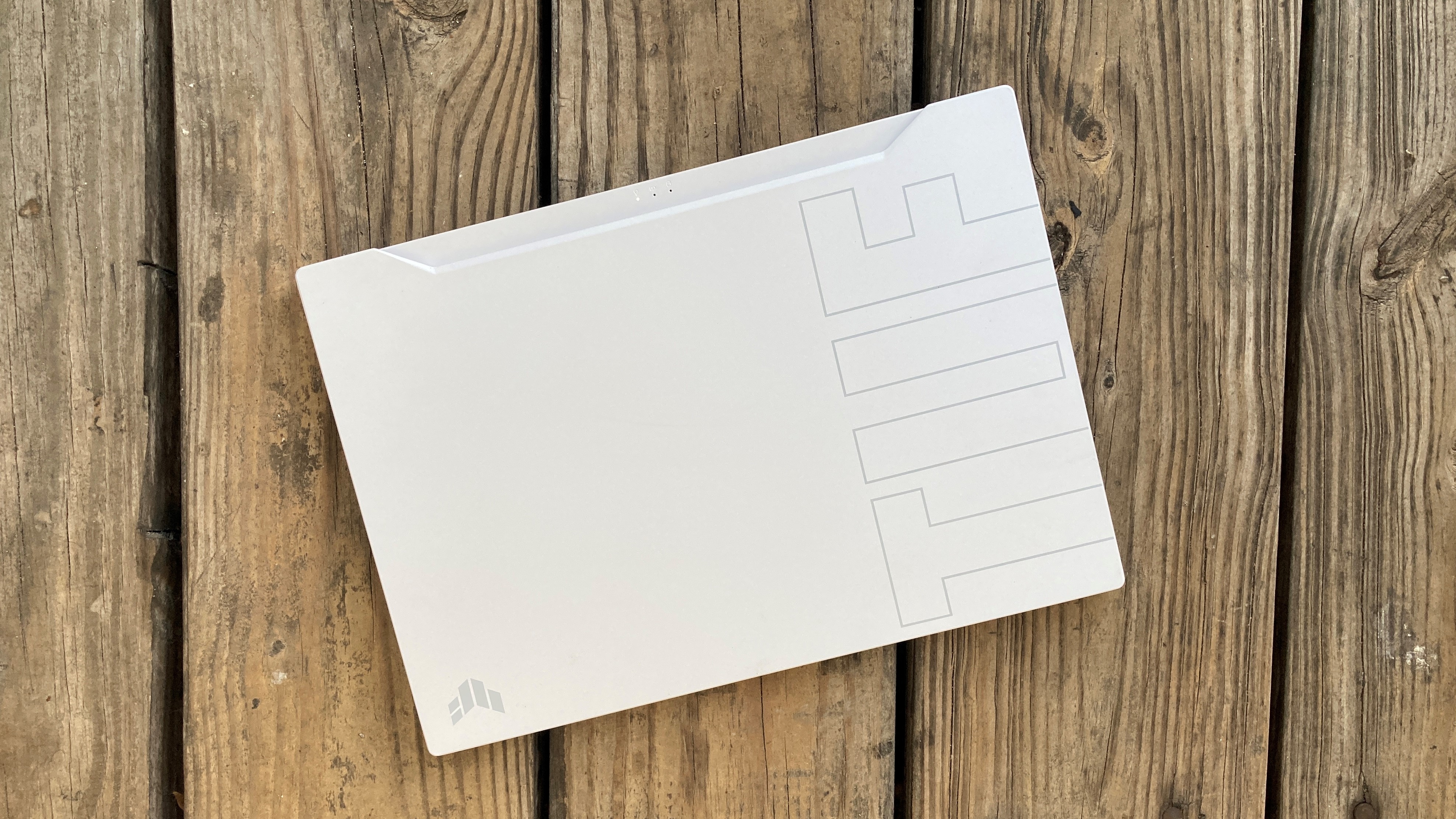
On the non-gaming heat test (15 minutes of video streaming), the touchpad, underside and center of the keyboard reached 71 degrees, 87 degrees and 89 degrees Fahrenheit, respectively. The latter temperature surpassed our 95-degree comfort threshold.
After gaming for 15 minutes, the touchpad reached a comfortable 78 degrees. However, the center of the keyboard and underside sizzled, hitting to 108 degrees and 126 degrees, respectively. The latter might seem high, but I played Hitman 3 on the TUF Dash F15 for about an hour and the chassis remained pleasantly cool (especially the palm rests and the keyboard) as I hunted for my next victim.
Asus TUF Dash F15 webcam
What webcam? You won’t find anything of the sort on the TUF Dash F15. After reviewing the Gigabyte Aero 15 — a gaming laptop with a poorly angled camera on its deck — I will not clown Asus’ decision to scrap the webcam.
Asus had to make a difficult decision: thicken the top bezel to include a webcam, place the camera elsewhere, or ditch the webcam altogether. Personally, I would have taken the thicker bezel, but ditching the webcam is the next best thing. Trust me; webcams located on the laptop's chin or deck are horrendous — and Asus knows it.
Thankfully, you can always attach an external webcam to the laptop. Check out our best webcams page for some excellent options.
Asus TUF Dash F15 software and warranty
The TUF Dash 15 has useful software that gamers will appreciate, including the Armoury Crate app. The Armoury Crate app reveals information about the processor, GPU, memory and fans.

You can also tweak your display settings with seven presets: Racing, Scenery, RPG, FPS, Cinema, Eyecare and Vivid. When I switched on the Eyecare preset, which adjusts the gamma value, saturation and hue to reduce blue light, my eyes immediately felt a sense of relief. The Armoury Crate app even has a deals tab that offers discounts to ROG VIP members. I also spotted a tab for news regarding updates about the company.
The Nvidia GeForce Experience app is also present, which is the ideal destination for updating your drivers. The TUF Dash F15 runs on Windows 10, so you’ll also find some bloatware like Microsoft Solitaire Collection, Skype and McAfee Personal Security, but it’s not excessive.
The Asus TUF Dash F15 comes with a one-year limited warranty. See how Asus fared on Tech Support Showdown and Best and Worst Brands our annual special reports.
Bottom line
The Asus TUF Dash F15 rolled into the new year with style. While all the other laptops decided to stick with a depressing grunge look with dreary grays and blacks, the TUF Dash F15 said, “Hey, let’s have an all-white party!” The TUF Dash F15 also has a sturdy design that matches its name — its military-tested chassis is, indeed, a “tough cookie” that can take a beating.
It also remained relatively cool in all the places that matter so you don’t have to worry about the TUF Dash F15 burning your fingers off while gaming. It doesn’t offer industry-leading frame rates like the Alienware m15 R4, but it can handle your favorite triple-A titles at playable levels. Plus, the TUF Dash F15 costs $1,000 less.
Unfortunately, the TUF Dash F15 comes without a webcam and the display is dim, but on the plus side, that lackluster screen burns less energy and saves power. The TUF Dash F15 has the best battery life compared to its two Nvidia 30-series competitors.
The TUF Dash F15 is a great sub-$1,500 laptop that can handle all your productivity tasks by day and tackle all of your gaming needs by night.
Kimberly Gedeon, holding a Master's degree in International Journalism, launched her career as a journalist for MadameNoire's business beat in 2013. She loved translating stuffy stories about the economy, personal finance and investing into digestible, easy-to-understand, entertaining stories for young women of color. During her time on the business beat, she discovered her passion for tech as she dove into articles about tech entrepreneurship, the Consumer Electronics Show (CES) and the latest tablets. After eight years of freelancing, dabbling in a myriad of beats, she's finally found a home at Laptop Mag that accepts her as the crypto-addicted, virtual reality-loving, investing-focused, tech-fascinated nerd she is. Woot!
